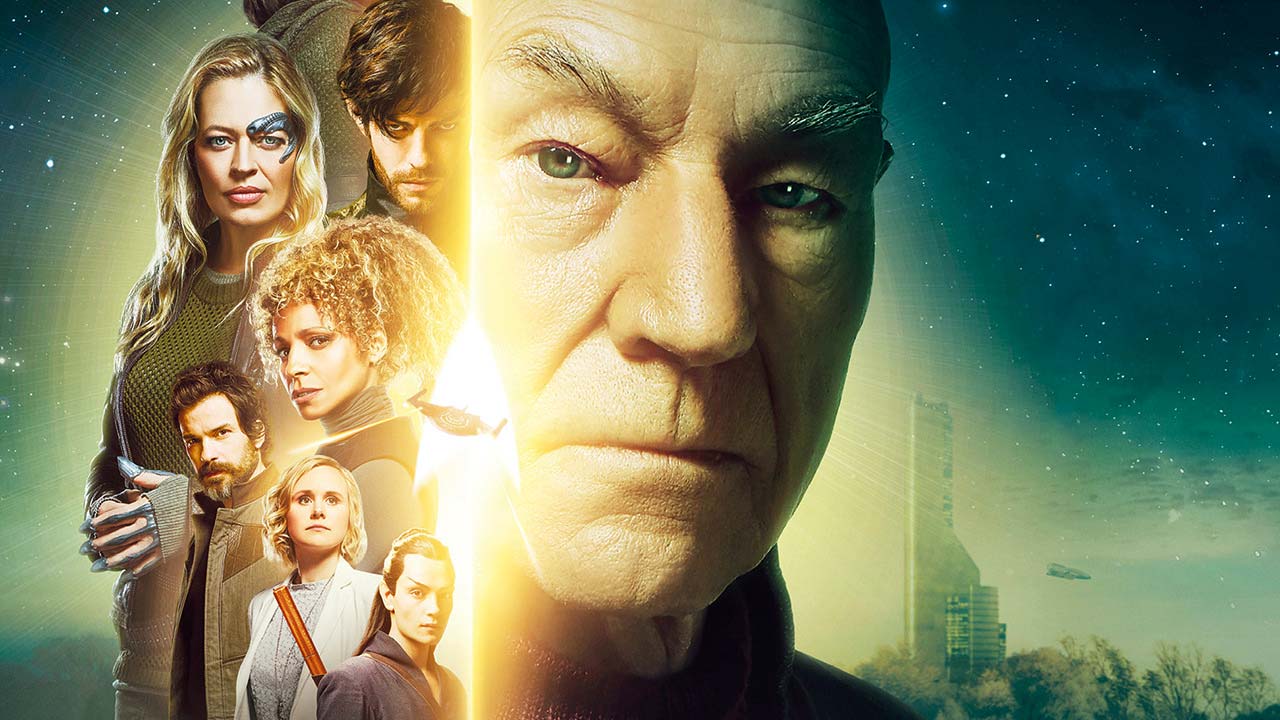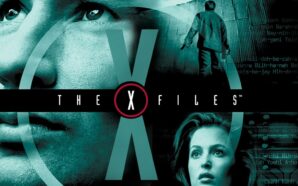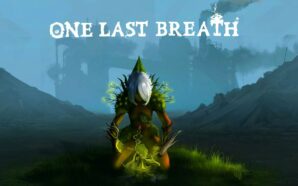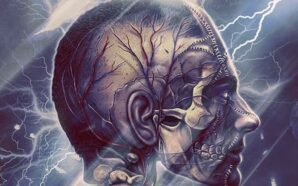Red alert! Shields up! Spoilers inbound!
Last week, Star Trek: Picard came to strange and surprising end as Jean-Luc and his motley crew saved the galaxy and, much more interestingly, exorcised their own personal demons. At least, I think that’s what was happening. It’s been a bizarre season of television, rapidly alternating in quality in rather extreme ways while the plot threatened to smother the themes and characters the series was interested in at the beginning of its run, but the spark of a great show was always there, sometimes more visible than others. I’ve previously discussed the premiere (which I enjoyed a lot) and the following four episodes (which were much more of a mixed bag) and now that the season is complete, join me as I look back at episodes 6 through 10 of Picard’s debut season and explore whether the ending we received was at all satisfying.
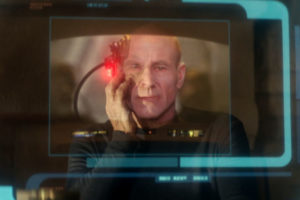 After ‘Stardust City Rag’ greatly disappointed and offered us a new but most definitely not improved version of Seven of Nine, the series bounced back with ‘The Impossible Box’, which might be the best episode of Picard. I don’t think it’s my favourite episode or the best Star Trek episode of the bunch, but rather it’s the most successful instalment to really nail down the tone and pacing that the series is trying to accomplish. There’s no bad subplot or scene that sticks out as much worse than any other. After a few episodes of (mostly enjoyable) flailing, all the characters and their stories collide as the plot kicks into gear. Using information gained from Maddox, Picard and the crew of La Sirena arrive at the Borg cube while Soji discovers the truth behind her existence and origin, with the nefarious help of Narek. Just as our characters are finally united, they split up again on different paths, with Soji joining Picard, in a mid-season break of the status quo.
After ‘Stardust City Rag’ greatly disappointed and offered us a new but most definitely not improved version of Seven of Nine, the series bounced back with ‘The Impossible Box’, which might be the best episode of Picard. I don’t think it’s my favourite episode or the best Star Trek episode of the bunch, but rather it’s the most successful instalment to really nail down the tone and pacing that the series is trying to accomplish. There’s no bad subplot or scene that sticks out as much worse than any other. After a few episodes of (mostly enjoyable) flailing, all the characters and their stories collide as the plot kicks into gear. Using information gained from Maddox, Picard and the crew of La Sirena arrive at the Borg cube while Soji discovers the truth behind her existence and origin, with the nefarious help of Narek. Just as our characters are finally united, they split up again on different paths, with Soji joining Picard, in a mid-season break of the status quo.
By far my favourite aspect of ‘The Impossible Box’ is seeing Picard face his past as Locutus on the Borg cube, reuniting with Hugh in the process. While First Contact saw Picard grapple with his past experience with the Borg, the episode comes at it from a different angle. We see less anger than what was on display in that TNG film – the best of the four – and more fear now that Picard is a much older character. His anxiety and fear give way once he witnesses Hugh’s reclamation project, turning the fearsome drones into deborgified xBs. Whereas, despite the progress he made, First Contact still ends with Picard destroying all the Borg, his growth here instead allows him to see them as victims rather than weapons and even contemplates vouching for them to Starfleet.
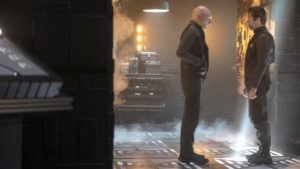 We see that Picard is growing and learning, not just since the movies but also from earlier in the season. In ‘Absolute Candor’, we learn that he let perfection be the enemy of good, choosing to abandon his aid of any Romulans because he couldn’t save all of them. In ‘The Impossible Box’, Hugh is frustrated that he can’t do more to help all the Borg drones on the cube and Picard tells him to forget striving for perfection and instead focus on the good work he is doing. I really love this moment because it shows Picard sharing wisdom that he too has only just learnt. He’s applying this newfound insight to other aspects of his journey and I like that the series is drawing parallels between the Romulans, xBs and later the androids as races who are severely damaged and dejected by galactic events, threatened by extinction, but come out fighting to regain their strength and identity, in ways both good and bad. Continuing this idea, while Picard doesn’t become an advocate for the xBs, he does for the Synths at the end of the season.
We see that Picard is growing and learning, not just since the movies but also from earlier in the season. In ‘Absolute Candor’, we learn that he let perfection be the enemy of good, choosing to abandon his aid of any Romulans because he couldn’t save all of them. In ‘The Impossible Box’, Hugh is frustrated that he can’t do more to help all the Borg drones on the cube and Picard tells him to forget striving for perfection and instead focus on the good work he is doing. I really love this moment because it shows Picard sharing wisdom that he too has only just learnt. He’s applying this newfound insight to other aspects of his journey and I like that the series is drawing parallels between the Romulans, xBs and later the androids as races who are severely damaged and dejected by galactic events, threatened by extinction, but come out fighting to regain their strength and identity, in ways both good and bad. Continuing this idea, while Picard doesn’t become an advocate for the xBs, he does for the Synths at the end of the season.
Picard and Soji transport themselves light years away from the Borg cube and end up on Nepenthe for a quick breather in what is most definitely the best 75% of an episode all season. We witness Picard’s long-awaited reunion with Riker and Troi who live on the planet, along with their daughter Kestra, mourning their late son Thad. This is all great from Picard’s point-of-view as he meets up with his old crew mates, allowing us to explore the former Admiral’s headspace while he comes up with a plan for what to do next. But the episode is truly remarkable from Soji’s perspective as she struggles to come to terms with her whole life being a lie. She’s a fake girl trying to understand her reality through the fake make-believe fantasy worlds created by a dead boy. Kestra aids her on her journey as she comes to trust Picard and the loving family around her. When it comes to child/teen characters in TV and movies, I’m like season one of The Next Generation Picard. I hate them; they annoy me. So, the episode’s greatest success is making Kestra seem incredibly charming and fun. I love that character and if they do end up making a Starfleet Academy series then I know who I’d want as the lead.
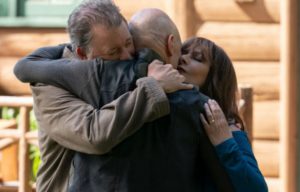 It’s great seeing Riker again, especially hearing him shout ‘shields up’ once more, with the older version of the character being fuelled totally by Frakes’ natural charm as he relaxes retired from Starfleet, all smiles and chest hair and pizza. But it’s Troi who really blew me away in ‘Nepenthe’. I’ve never cared for the character that much and you can count the number of good TNG episodes she takes the lead in on one hand. She’s usually fine but is definitely one of the weakest characters, and performances, of The Next Generation. Decades later however, the character is much better written and Marina Sirtis gives a wonderful performance, whether talking about her dead son or using her counselling skills much more successfully than we’ve ever seen before. That scene where she has to stand up to Picard and fight for Soji’s agency, as a woman who has undergone huge trauma in her past, is fantastic and probably my favourite of the entire season. Such a scene could have gone horribly wrong but I thought it was written and performed in a pitch perfect manner.
It’s great seeing Riker again, especially hearing him shout ‘shields up’ once more, with the older version of the character being fuelled totally by Frakes’ natural charm as he relaxes retired from Starfleet, all smiles and chest hair and pizza. But it’s Troi who really blew me away in ‘Nepenthe’. I’ve never cared for the character that much and you can count the number of good TNG episodes she takes the lead in on one hand. She’s usually fine but is definitely one of the weakest characters, and performances, of The Next Generation. Decades later however, the character is much better written and Marina Sirtis gives a wonderful performance, whether talking about her dead son or using her counselling skills much more successfully than we’ve ever seen before. That scene where she has to stand up to Picard and fight for Soji’s agency, as a woman who has undergone huge trauma in her past, is fantastic and probably my favourite of the entire season. Such a scene could have gone horribly wrong but I thought it was written and performed in a pitch perfect manner.
But as I said, ‘Nepenthe’ is only 75% great and the other 25% – the subplot on the Borg cube – is very disappointing. Elnor is left behind on the massive object and, despite an interesting concept, his character is never given much to do but kill people. After plotting to take control of the cube away from the Romulans, Hugh is unceremoniously killed for no reason other than to replace him with Seven in the next episode. Both Hugh and Seven could play the same role and so Hugh’s time is cut short to make way for the bigger character, although I’d much rather continue following this updated version of Hugh than the rubbish vigilante update of Seven.
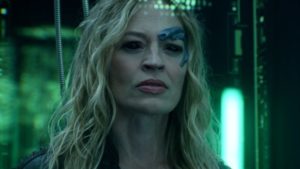 The disappointment of the Borg cube is continued in the next episode, ‘Broken Pieces’, as Seven magically appears from nowhere and briefly becomes the Borg Queen for all of two minutes for no reason whatsoever. She reactivates the drones to defeat the Romulans and just when you think that we’re in for ten minutes of incredible Borg-vs-Romulan action, Narissa opens the airlock and they all go tumbling into space. Seven then stops being the Queen and the Romulans leave anyway. What was the point of all this? There’s none of the much needed build up to Seven choosing the massive decision about becoming the Queen and there’s no consequences to the huge action either.
The disappointment of the Borg cube is continued in the next episode, ‘Broken Pieces’, as Seven magically appears from nowhere and briefly becomes the Borg Queen for all of two minutes for no reason whatsoever. She reactivates the drones to defeat the Romulans and just when you think that we’re in for ten minutes of incredible Borg-vs-Romulan action, Narissa opens the airlock and they all go tumbling into space. Seven then stops being the Queen and the Romulans leave anyway. What was the point of all this? There’s none of the much needed build up to Seven choosing the massive decision about becoming the Queen and there’s no consequences to the huge action either.
I think that the events on the Borg cube could have been an entire episode to give these decisions the weight they deserve, and so we had enough time to see the Borg in all their assimilating glory. We know the season was restructured during production, with the first two episodes becoming three, so there must have been an episode from later in the season heavily altered to condense the plot. I imagine Seven’s actions on the cube were once explored more but were sadly reduced to the meaningless subplot they became.
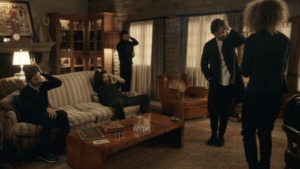 I don’t think all of ‘Broken Pieces’ is bad however, in fact the events taking place on La Sirena are well executed. It’s very much an episode in which plot, thankfully, takes a back seat and the character arcs of the show’s supporting characters get some resolution. Jurati finally gets to meet a flesh-and-blood sentient android and witnessing her life’s pursuit with her own eyes makes her reconsider the terrible truth shown to her by Oh. Rios overcomes his past trauma, although the coincidence that he has encountered one of Maddox’s androids before is a little too silly. Santiago Cabrera gets time to shine – or embarrass himself, depending on which accent he’s doing – with the scene in which he plays all five of Rios’ holograms. It’s a fun scene and I like that Picard is finding time for silly moments, this one working better than anything in ‘Stardust City Rag’. Raffi is proven right in her conspiracy theories and is vindicated by the truth behind the Mars attack being revealed. Which is fine. I just don’t care for the character, Michelle Hurd’s constant sassy head shaking or the treatment of her alcoholism storyline.
I don’t think all of ‘Broken Pieces’ is bad however, in fact the events taking place on La Sirena are well executed. It’s very much an episode in which plot, thankfully, takes a back seat and the character arcs of the show’s supporting characters get some resolution. Jurati finally gets to meet a flesh-and-blood sentient android and witnessing her life’s pursuit with her own eyes makes her reconsider the terrible truth shown to her by Oh. Rios overcomes his past trauma, although the coincidence that he has encountered one of Maddox’s androids before is a little too silly. Santiago Cabrera gets time to shine – or embarrass himself, depending on which accent he’s doing – with the scene in which he plays all five of Rios’ holograms. It’s a fun scene and I like that Picard is finding time for silly moments, this one working better than anything in ‘Stardust City Rag’. Raffi is proven right in her conspiracy theories and is vindicated by the truth behind the Mars attack being revealed. Which is fine. I just don’t care for the character, Michelle Hurd’s constant sassy head shaking or the treatment of her alcoholism storyline.
‘Broken Pieces’ ends with a great speech by Picard to Rios about how Starfleet has betrayed them. It’s a moment that works well for the characters but less so the plot. In the instance they’re talking about – Rios’ former captain murdering two androids before killing himself – it’s the Romulans to blame, not Starfleet. Oh specifically, not the organisation she’s hidden herself within. Starfleet has seemingly betrayed their ideals and is a very different organisation now, but this is still too ill-defined. How exactly have they changed? We don’t know because we haven’t seen them at all. Maybe that’s the point and they are far too isolationist now but for a such a huge development in the galaxy, we see or hear very little about it. We just know it’s bad. It’s hard to explore why and how they have betrayed the characters because Starfleet just isn’t a presence in the show other than old potty mouth Clancy. I hope that this is rectified in the second season.
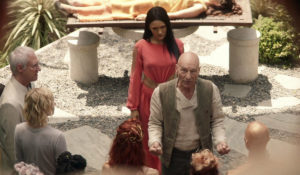 This brings us to the first episode of the two-part season finale: ‘Et in Arcadia Ego’. Latin is only bested by Shakespeare in the long-running pretentiousness of Star Trek episode titles. It’s an episode that I’m still shocked by. I thought it was terrible. Pretty much every aspect disappointed me and decreased by enjoyment of the series – which was quite high – dramatically. Every detail just seemed off and poorly executed. Jurati poisoning herself to disable her tracker was pointless because Narek still followed them somehow. The planet that is supposed to be covered by permanent lightning storms – the crucial detail that led them to the location – is constantly sunny. The androids all look really goofy with the makeup looking like weird fake tan and the loose clothing making it seem like we were watching an episode of ‘Star Trek: Love Island’ set on Risa. The Admonition was actually left for androids and we discover this through an android doing a mind meld. It’s a nerdy nit-pick but, unlike a neck pinch, the mind meld is an innate telepathic ability rather than something that can be learned. Giant flowers? Okay, I quite like the giant space flowers.
This brings us to the first episode of the two-part season finale: ‘Et in Arcadia Ego’. Latin is only bested by Shakespeare in the long-running pretentiousness of Star Trek episode titles. It’s an episode that I’m still shocked by. I thought it was terrible. Pretty much every aspect disappointed me and decreased by enjoyment of the series – which was quite high – dramatically. Every detail just seemed off and poorly executed. Jurati poisoning herself to disable her tracker was pointless because Narek still followed them somehow. The planet that is supposed to be covered by permanent lightning storms – the crucial detail that led them to the location – is constantly sunny. The androids all look really goofy with the makeup looking like weird fake tan and the loose clothing making it seem like we were watching an episode of ‘Star Trek: Love Island’ set on Risa. The Admonition was actually left for androids and we discover this through an android doing a mind meld. It’s a nerdy nit-pick but, unlike a neck pinch, the mind meld is an innate telepathic ability rather than something that can be learned. Giant flowers? Okay, I quite like the giant space flowers.
I just can’t believe how bad the penultimate episode is. Even the direction is off with weird angles and cuts. The reveal of a new Soong, who eyerolling-ly has the initials AI, is very poorly executed. He just walks out of a building in a very odd shot and is suddenly part of the conversation, no rigmarole or anything. I guess it parallels how the character just wanders into the story, a character who should be more impactful and whose existence cheapens the actions of his much more interesting father. Soong treated Data like a son so finding out that he actually had a son weakens this bond, at least with the limited exploration we get. I can’t help thinking that Bruce Maddox should have survived somehow and that he should be that character with the androids in the final two episodes instead of Soong.
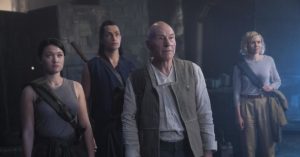 The final episodes seemed to copy Discovery’s playbook by having the final episode feature a big space battle, or at least confrontation, and the penultimate episode relegated to characters apparently getting further resolution by simply staring into each other’s wet eyes and saying how much they love each other while melodramatic music plays. For such a big episode, all the information we receive and the choices characters make based on it are incredibly rushed. We should have spent more time with this community of androids than half an episode and Soji’s decision doesn’t track for me. It’s a very messy 45 minutes of television. Even my discussion of this episode is a mess. I’m just baffled by so many of the choices.
The final episodes seemed to copy Discovery’s playbook by having the final episode feature a big space battle, or at least confrontation, and the penultimate episode relegated to characters apparently getting further resolution by simply staring into each other’s wet eyes and saying how much they love each other while melodramatic music plays. For such a big episode, all the information we receive and the choices characters make based on it are incredibly rushed. We should have spent more time with this community of androids than half an episode and Soji’s decision doesn’t track for me. It’s a very messy 45 minutes of television. Even my discussion of this episode is a mess. I’m just baffled by so many of the choices.
Sutra’s mind meld with Agnes reveals the truth behind the Admonition. It’s not a warning but an invitation for other synthetic life to rise up and destroy their creators, along with a futuristic phone number to call for help from ancient advanced androids from a hell portal. An invitation made up of public domain stock images. I swear, if I see that decomposing fox again somewhere, I’m going to lose it. I’m not a fan of these ancient galaxy-threatening synths. It’s an element that feels too disconnected; a third party introduced too late in the game. I find it interesting that the Admonition isn’t the only birth place of the Romulan’s fear of Soji and her AI brethren but that there’s also some ancient myth about demons and armageddon. The way it’s explained in the show is slightly confusing about whether this and the Admonition have always been connected – history and make-believe coalescing in one story – or if the Romulan myth is something unto itself.
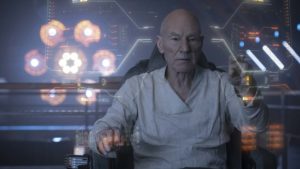 After ten weeks we finally get to the season finale of the show and it’s… okay. I think there were a few very good moments and the season ended by returning to some key themes in fascinating ways, but it’s hard not to feel that they whiffed the ending in terms of resolving the plot between the androids and the Zhat Vash. Picard helms La Sirena and makes the ultimate sacrifice to show Soji the humanity she seeks to quell, making her change her mind and shut down the beacon. I was impressed by Picard’s dialogue during his ‘final moments’ and the impact they had were far stronger than his ‘death’. Michael Chabon’s dialogue is often very good but his plotting less so.
After ten weeks we finally get to the season finale of the show and it’s… okay. I think there were a few very good moments and the season ended by returning to some key themes in fascinating ways, but it’s hard not to feel that they whiffed the ending in terms of resolving the plot between the androids and the Zhat Vash. Picard helms La Sirena and makes the ultimate sacrifice to show Soji the humanity she seeks to quell, making her change her mind and shut down the beacon. I was impressed by Picard’s dialogue during his ‘final moments’ and the impact they had were far stronger than his ‘death’. Michael Chabon’s dialogue is often very good but his plotting less so.
Rios, Raffi, Elnor and Narek put an end to the android plot on the planet while Riker, commanding not just a ship but an entire fleet, appears to drive the Romulans away. Plot-wise, it’s a fairly standard and slightly dull conclusion although one that felt very much like The Lord of the Rings to me. Picard whispering to a butterfly while in captivity just like Gandalf, his waking up surrounded by friends later in the episode, some of the music and Narek’s recounting of the Romulan myth all felt similar to the fantasy trilogy of films.
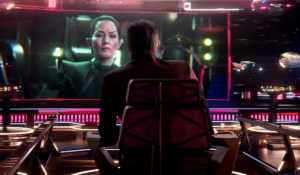 Riker’s return was sadly spoilt by Frakes’ appearance in the opening credits as a guest star but it was fun to see him back in uniform and commanding a ship. It looks as if he was filmed against a green screen though which is a shame and gave his scenes a fan film feel. The visual effects are usually fantastic in the series, particularly that shot of the Borg cube exiting the transwarp conduit in the penultimate episode, but they were a little wonky in the finale. It’s a shame that all the Starfleet ships were identical. If that’s the case then just make the fleets smaller. The size of them is preposterous. I do like that the confrontation between the fleets ended in a very Star Trek way of minimal violence and no grandiose space battle, and Oh ordering “Planetary sterilisation pattern #5” was a very silly but fun line. How many planetary serialisation patterns do you need?
Riker’s return was sadly spoilt by Frakes’ appearance in the opening credits as a guest star but it was fun to see him back in uniform and commanding a ship. It looks as if he was filmed against a green screen though which is a shame and gave his scenes a fan film feel. The visual effects are usually fantastic in the series, particularly that shot of the Borg cube exiting the transwarp conduit in the penultimate episode, but they were a little wonky in the finale. It’s a shame that all the Starfleet ships were identical. If that’s the case then just make the fleets smaller. The size of them is preposterous. I do like that the confrontation between the fleets ended in a very Star Trek way of minimal violence and no grandiose space battle, and Oh ordering “Planetary sterilisation pattern #5” was a very silly but fun line. How many planetary serialisation patterns do you need?
Picard is aided not only by Jurati but also a weird device given to him by the Synths that can seemingly do absolutely anything. It’s Star Trek’s answer to the sonic screwdriver and I really dislike the weird technobabble device. I see its inclusion as a very knowing and meta comment of technology in Star Trek doing whatever the writer needs for the plot to resolve but explicitly playing into this trope with an unexplainable device doesn’t excuse the trope, especially in such a pivotal moment. It was fun seeing the Picard manoeuvre, and I laughed at Jurati replicating her face, but that weird blue object cheapened the moment.
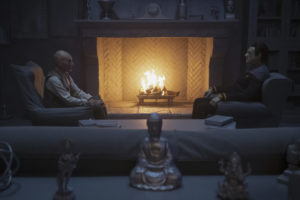 Picard dies but the moment didn’t affect me at all, with the golem seen in the previous episode clearly going to be used to resurrect him. After debating the logic of sacrifice in the finale’s first part, Picard’s actions do make sense, especially with him being terminally ill. His diagnosis was largely an undiscussed motivation for him throughout the season and I think more could have been done with it. The aged admiral is now closer to Data than ever, inhabiting a synthetic body of his own, and I’m interested in how this will be explored going forward. Soong seems to have created a way for everyone to be immortal but I’m sure the series will gloss over that and I want Picard to continue to argue for Synth rights. I could see that being his purpose in the second season but considering the ban is abruptly lifted offscreen, I’m unsure just what the impact of Picard’s new form will be.
Picard dies but the moment didn’t affect me at all, with the golem seen in the previous episode clearly going to be used to resurrect him. After debating the logic of sacrifice in the finale’s first part, Picard’s actions do make sense, especially with him being terminally ill. His diagnosis was largely an undiscussed motivation for him throughout the season and I think more could have been done with it. The aged admiral is now closer to Data than ever, inhabiting a synthetic body of his own, and I’m interested in how this will be explored going forward. Soong seems to have created a way for everyone to be immortal but I’m sure the series will gloss over that and I want Picard to continue to argue for Synth rights. I could see that being his purpose in the second season but considering the ban is abruptly lifted offscreen, I’m unsure just what the impact of Picard’s new form will be.
While Soong is preparing his new and shockingly nude body, Picard is left in a digital nether realm with Data, whose memories live on after being harvested from B4. It’s a really touching scene and one of the best of the season, even if it is a little bizarre and comes out of nowhere. Has Data been alone this whole time in there? Can’t anyone else talk to him? Can they not transfer his mind into a new body like Picard? There are many questions but focusing on the fake science takes away from what is truly a spiritual encounter. The scene closes out two themes and driving forces behind the season: Picard’s struggle with mortality and him being able to finally say goodbye to Data, shedding the cold emotionless exterior he wore in TNG and reveal to the android how he feels about him. Picard ends his struggle with Data’s death in a novel way – by killing him, this time on his own terms and understanding.
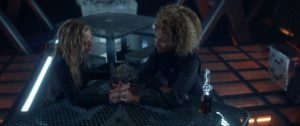 Meanwhile, Seven is still hanging around doing nothing of importance. After killing Narissa, just like Bjayzl earlier in the season, she realises that revenge leaves you feeling cold and unfulfilled, vowing to pursue something else in her life. Seven is a character the writers had no time to actually deconstruct and so we just get the cliff notes of character development, this revelation being one of many unearned moments she has during the season. She even ends the season as part of the crew and holding hands with Raffi after spending all but 30 seconds together. I noticed that Raffi is drinking at end with Seven so I guess she’s no longer sober, if she ever was. Her arc just doesn’t make sense, although I did enjoy seeing her act in a motherly way with Elnor after her son shunned her earlier in the season.
Meanwhile, Seven is still hanging around doing nothing of importance. After killing Narissa, just like Bjayzl earlier in the season, she realises that revenge leaves you feeling cold and unfulfilled, vowing to pursue something else in her life. Seven is a character the writers had no time to actually deconstruct and so we just get the cliff notes of character development, this revelation being one of many unearned moments she has during the season. She even ends the season as part of the crew and holding hands with Raffi after spending all but 30 seconds together. I noticed that Raffi is drinking at end with Seven so I guess she’s no longer sober, if she ever was. Her arc just doesn’t make sense, although I did enjoy seeing her act in a motherly way with Elnor after her son shunned her earlier in the season.
So, where does the show go from here? I have absolutely no idea. I was very disappointed that the ban on synthetics was suddenly lifted without any exploration into the ramifications of such an action, or the effects of the Federation learning that the Romulans were behind the attack on Mars. One more scene between Picard and Admiral Clancy is the least they could have done. But hopefully that means the show will explore these things in the second season, along with the attitude of Starfleet. We also don’t know what happened to Narek who seemed to just disappear, as did the other Synths. Surely they are still in danger from Zhat Vash, especially after they witnessed a portal to AI Hell open up in front of them. What’s to stop the Romulan fleet returning? And I’m putting good money on Narissa still being alive. She’s used that emergency transporter to save herself from certain death before.
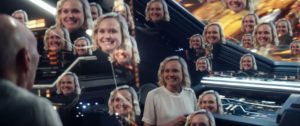 Now that the season has concluded, it’s clear that the further the series gets from the titular Picard, the worse it becomes. The show begins with a plot in which it makes sense for him to be deeply and personally invested but by the end it escalates into something beyond the purview of his character. Finding and aiding Data’s daughter? Yes. Civilization of ancient AI hellbent on total biological destruction? No. And by the time the season wraps up, and tries to pull focus back on Picard, there’s so much extra unnecessary baggage in the way that it’s hard to do so clearly. The series returns to its initial themes right at the conclusion, but it was a twisting road from the beginning of the season to the end, full of narrative cul-de-sacs.
Now that the season has concluded, it’s clear that the further the series gets from the titular Picard, the worse it becomes. The show begins with a plot in which it makes sense for him to be deeply and personally invested but by the end it escalates into something beyond the purview of his character. Finding and aiding Data’s daughter? Yes. Civilization of ancient AI hellbent on total biological destruction? No. And by the time the season wraps up, and tries to pull focus back on Picard, there’s so much extra unnecessary baggage in the way that it’s hard to do so clearly. The series returns to its initial themes right at the conclusion, but it was a twisting road from the beginning of the season to the end, full of narrative cul-de-sacs.
Barring ‘Stardust City Rag’, I enjoyed the first eight episodes of the show but the final two were a disappointment. The season long plot came to a rather lacklustre, but not outright bad, end that could have been much stronger. ‘Et in Arcadia Ego Part 2’ was superior to the first part and once the unnecessary large-scale conflict between androids, Romulans and Starfleet concluded, the scenes returning us to Picard’s personal and emotional struggles were handled well and prevented the ending from being a total bust. There’s a good story in there but the series seemed to get away from the writers as it drew to a close. Chabon managed to wrangle the oversized beast just enough to make Picard’s personal journey come to a satisfying end, even if the galaxy and stories around him didn’t.
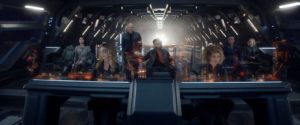 Despite the numerous missteps and flaws, I enjoyed Star Trek: Picard’s first season and look forward to hopefully an improved second instalment of the series. I was becoming tired of the show as it entered its final act but there’s enough potential there for future stories to build on the somewhat shaky foundations the finale left the series on. I hope that the writers remember the title of the series as they are writing the second season and never let the show spiral so far away from Picard’s personal journey again. When Picard is onscreen and the focus of the narrative, and when character work isn’t so outweighed by plot, the show succeeds.
Despite the numerous missteps and flaws, I enjoyed Star Trek: Picard’s first season and look forward to hopefully an improved second instalment of the series. I was becoming tired of the show as it entered its final act but there’s enough potential there for future stories to build on the somewhat shaky foundations the finale left the series on. I hope that the writers remember the title of the series as they are writing the second season and never let the show spiral so far away from Picard’s personal journey again. When Picard is onscreen and the focus of the narrative, and when character work isn’t so outweighed by plot, the show succeeds.
What did you think of Star Trek: Picard’s first season? Let me know in the comments and be sure to geek out with me about TV, movies and video-games on Twitter @kylebrrtt.




